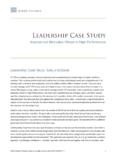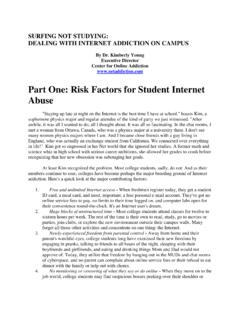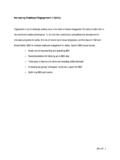Transcription of Developing StrengthS or WeakneSSeS - Zenger Folkman
1 610 East Technology Avenue, Building B | Orem, UT 84097 PHONE FAX of the basic questions facing everyone creating a personal development plan is the fundamental question of whether to focus attention on correcting faults and fail-ings or whether to focus on building StrengthS . Like many questions that appear simple, there are some interesting complexities. The answer to the question depends on the competencies of the person involved. And the answer for any one person can vary over faLL into three categoriesThe first issue to be considered is whether or not the person in question possesses one or more fatal flaws. After analyzing over 6,000 leaders in our database on the dimension of possessing StrengthS or WeakneSSeS , we observed that they are arrayed into three, roughly equal following chart summarizes those three groups and how they are perceived by the people who work with them.
2 The first group consists of those who have one or more WeakneSSeS . We ve defined that serious weakness as a fatal flaw. It describes some behavior at the 1st to the 10th percentile. Note that as a group that they are seen to be performing at the 18th percentile in the eyes of their peers, direct reports and bosses. The second group consists of those who have neither StrengthS nor WeakneSSeS . StrengthS are behaviors or competencies at the 90th percentile and above. This sec-ond group also has about one-third of the population of leaders in it. Overall it is seen as performing right in the middle of the curve, or at the 50th percentile. Third, there is a group of leaders who have one or more StrengthS and it also contains approximately one-third of the leader population. As a group they are perceived as performing at the 81st When a StrengthS focus is poor adviceHaving a fatal flaw gets in the leader s way.
3 This leader should not spend time working on Developing StrengthS at this time. It is extremely important to first correct the obvious flaw. Only when it is been improved does it be-come useful for a person in the left hand group to work on Developing a strength . Therefore, for one-third of the 1 (We should note that 2% of leaders have both StrengthS and WeakneSSeS , but because this is such a small portion of all leaders, we ll ignore them for purposes of this analysis.)Impact of Fatal Flaws and Profound StrengthsExtraordinary Performance. StrengthS or WeakneSSeS :Overcoming the Lure of the Wrong Choice by Jack Zenger2 Copyright 2008 Zenger | population, the focus should be to correctly identify the weakness and get it s a metaphor that may help to explain that principle. You need a piano moved into a second story apartment, and it won t fit in the elevator. You hire two men to move your piano.
4 Let s assume there s a state of physical fitness that the average piano mover enjoys and we ll call that 0. If our piano movers have the flu, have broken limbs or bad backs; they are in minus territory. Getting them back to 0 is mandatory if the job is to get done. This is the arena where working on WeakneSSeS is necessary and pays off. But getting our piano movers to zero is not sufficient. In this case, being strong, having the stamina to carry the piano up two flights of stairs and having the ability to balance this heavy object as they go those are the StrengthS they ll need. It is the presence of StrengthS that ultimately gets the piano upstairs. After getting over the flu, having the broken leg heal and their back muscles no longer painful, then they can get in good condition to move the of our work in counseling, coaching and behavioral therapy has been to get people who are in negative territory up to ground zero.
5 We can t over emphasize the need to get that done. But never forget that such work only gets you to ground zero. Now the focus has to be on the positive deviance side of the equation where the real payoff comes. That is when building StrengthS come in to chaLL enge of fixing a WeaknessLeaders are prone to believe that they know their weak-nesses and their StrengthS . Our data confirms that self-scores on a 360 degree feedback instrument are notoriously deviant from everyone else s. As a rule, people are not accurate in their perception of their WeakneSSeS nor their StrengthS . That is why the 360 degree feedback process is so valuable. It ensures that people have more accurate data, which in turn provides both guidance and motivation in the improvement process. We believe that in general, fixing WeakneSSeS is harder than building StrengthS ; but motivated people with low scores need only do a few new things to begin to change those perceptions into positive territory.
6 When buiLding StrengthS is the correct adviceA popular idea of late has been to have leaders focus on Developing their StrengthS and largely ignore their WeakneSSeS . When is that good advice? For the second and third groups, or those leaders without any detracting weakness. To start with, it is clear that extraordinary leaders possess StrengthS . In our database containing 360 degree feedback results for tens of thousands of leaders, here s what the data shows: 64% have no StrengthS (that s roughly the bottom and middle third)11 percent have only 1 strength 15% have from 2 to 5 StrengthS . 10% have six or more. Organizations differ. In one extremely well managed financial services organization we found that 46% of the leaders had no strength , and that 33% had six or more. This rabbit ears distribution of StrengthS signaled a big opportunity for development of leadership skills with the nearly half who possessed no StrengthS at all.
7 The chaLL enge of getting Leaders to focus on strengthsHowever, convincing leaders to develop their StrengthS rather than hack away at their WeakneSSeS is hard work. Like Ulysses sailors being drawn to the Siren s song, and despite all the passionate encouragement we can give, the majority of leaders gravitate toward fixing their WeakneSSeS . For example, when we go back to groups of leaders who have put together their personal develop-ment plan some 12 to 18 months earlier, we dis-cover that about 60% are working on WeakneSSeS , nearly twice as many as should be. The tacit assumption appears to be something like: My StrengthS came from some unseen source. They will take care of themselves. My job is to discover what I m bad at and work on that. That s what real development is all about. Is it because so much of our early childhood development consisted of parents and teachers focusing on correcting weakness?
8 Is it some deeply imbedded cultural norm from which no one escapes? There are many possibilities, and no one knows the leaders to develop their StrengthS rather than hack away at their WeakneSSeS is hard 2008 Zenger | strengthsStrengths obviously range from the trivial to the titanic. Being really good at Rock Band may elevate you in your teenager s eyes; but would seldom be relevant to your work. We view StrengthS as important job skills or behaviors that apply to many situations, endure over an extended period and produce excellent results for the organization. Our operational definition of a strength is a behavior or trait that is seen by the combination of your boss, your peers and direct reports as something that you do at the 90th percentile. In other words, you re re-ally good at it. It is also something that has been shown to be important to people who lead in organizations.
9 It differentiates those who excel from those who history of focusing on strengthsThe first person whom we recall talking about StrengthS was Peter Drucker. In a variety of his speeches, writing and training films dating back to the 1950 s, Drucker highlighted the value of focusing on someone s StrengthS and lamented the strange process of companies hiring people for their skills and then immediately identify-ing their flat sides and expecting them to correct these deficiencies. With Drucker it was the leader s StrengthS that made the difference. Regrettably it appears that no one the past decade we ve had the advent of appreciative inquiry by David Cooperider, which is the application of the StrengthS philoso-phy at the organization level. We ve also had the M a rc u s B u c k i n g h a m books on the need for employees to discover their StrengthS . Our work at Zenger Folkman has focused on the relation-ship of StrengthS with extraordinary leadership.
10 Our research confirmed that a small number of StrengthS , specifically 4 or 5, elevated leaders to the top levels of their appeaL of strengthsThere is a strong logic to the argument about working on StrengthS . People seldom argue against the philosophy. This is reinforced when you show the compelling data that clearly shows that effective leadership is directly cor-related with the number of StrengthS a person possesses. Additionally, working on StrengthS , for most people, is more appealing and is the aLL ure of Working on WeakneSSeS ?There s something appealing about Mary Poppins who proclaims, I m practically perfect in every way. We all admire Thomas Jefferson who could write brilliantly, manage a plantation, invent and build clever devices for his home in Montecello and ultimately serve his country as President. In a strange way our educational system begins with ex-pecting every child to do well in every subject and it isn t until late in college and graduate school that we seem to acknowledge that people specialize and become good in specific and increasingly narrow the explosion of knowledge and technology has virtu-ally made the Renaissance person a myth.









